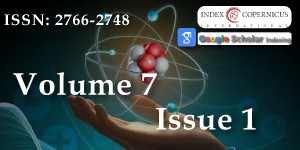Time Electron Theory
Main Article Content
Abstract
What is time? Is it a physical quantity, illusion, or dimension? Defining time is challenging and fascinating. We often consider time as a dimension to help us understand the concept of space-time. Time undeniably exists, but we can only sense its presence through its effects. For instance, if we take two apples, one bought months ago and the other just a day ago, we can tell that one apple was bought a long time ago because it had rotted. We express time as the effect caused by it. If there were no effects of time on this universe, then the concept of time would not exist [1,2].
Article Details
Copyright (c) 2024 Qadri SM.

This work is licensed under a Creative Commons Attribution 4.0 International License.
The International Journal of Physics Research and Applications is committed in making it easier for people to share and build upon the work of others while maintaining consistency with the rules of copyright. In order to use the Open Access paradigm to the maximum extent in true terms as free of charge online access along with usage right, we grant usage rights through the use of specific Creative Commons license.
License: Copyright © 2017 - 2025 |  Open Access by International Journal of Physics Research and Applications is licensed under a Creative Commons Attribution 4.0 International License. Based on a work at Heighten Science Publications Inc.
Open Access by International Journal of Physics Research and Applications is licensed under a Creative Commons Attribution 4.0 International License. Based on a work at Heighten Science Publications Inc.
With this license, the authors are allowed that after publishing with the journal, they can share their research by posting a free draft copy of their article to any repository or website.
Compliance 'CC BY' license helps in:
| Permission to read and download | ✓ |
| Permission to display in a repository | ✓ |
| Permission to translate | ✓ |
| Commercial uses of manuscript | ✓ |
'CC' stands for Creative Commons license. 'BY' symbolizes that users have provided attribution to the creator that the published manuscripts can be used or shared. This license allows for redistribution, commercial and non-commercial, as long as it is passed along unchanged and in whole, with credit to the author.
Please take in notification that Creative Commons user licenses are non-revocable. We recommend authors to check if their funding body requires a specific license.
Ilya P. Being Time and Becoming. World Scientific Publishing Company. 2003.
Dragan M. Emergent time. Stanford Encyclopedia of Philosophy. 2018. [https://plato.stanford.edu/entries/properties-emergent/](https://plato.stanford.edu/entries/properties-emergent/))
David K. Time Travel: A Philosophical Guide. Routledge. 2013.
Anders P, David BE. Quantum Theorien: A Textbook in the History of Ideas with a Philosophical Introduction. 2001. Springer.
Valentin GM. Quantum simulations of light propagation in dispersive media. Physical Review A. 2014; 89 (2): 023814. ([https://arxiv.org/abs/1307.7222](https://arxiv.org/abs/1307.7222))
Roger P. The Road to Reality. Alfred A. Knopf. 2004.
Patrick H. Traveling at the speed of thought: The influence of embodied time perception on mental rotation. Cognition. 2002; 82 (2): 177-209. ([https://www.frontiersin.org/articles/10.3389/fnbot.2014.00014](https://www.frontiersin.org/articles/10.3389/fnbot.2014.00014))
Wojciech ZH. Decoherence, einselection, and the quantum origins of the classical. Reviews of Modern Physics. 2003; 75 (3): 797. ([https://journals.aps.org/prl/abstract/10.1103/PhysRevLett.82.2860](https://journals.aps.org/prl/abstract/10.1103/PhysRevLett.82.2860))
Carlo R. The Order of Time. Riverhead Books. 2018.
Giovanni AC. Doubly Special Relativity. 2013.
Philip AW. More is different. Science. 1972; 177(4047): 393-396.
Thomas CM, Joy TA. Elements of Information Theory. Wiley-Interscience. 2006.
Vlatko V. Decoding Reality: The Universe as Quantum Information. Oxford University Press. 2010.
Yakir A. Can Entanglement Generate Realism? Physical Review A. 2008; 78 (1): 012106. [https://arxiv.org/abs/0706.2842](https://arxiv.org/abs/0706.2842))
McTaggart JMTE. A Commentary on Hegel's Logic. Cambridge University Press. 1908.
Murray GM. The Quark and the Jaguar. W. W. Norton & Company. 1995.
Per B. How Nature Works: The Science of Self-Organized Criticality. Copernicus. 1996.
Boccaletti S. Complex networks: Are there any nodes with essentially localized vibrations? Chaos. 2000; 10(4): 929-943.
Huw P. Time's Arrow and Archimedes' Point. Oxford University Press. 1997.
John P. Fault-Tolerant Error Correction. 1997. ([https://arxiv.org/abs/quant-ph/9712048] (https://arxiv.org/abs/quant-ph/9712048))
Carl H. Causality in Spacetime. Oxford University Press. 2013.

